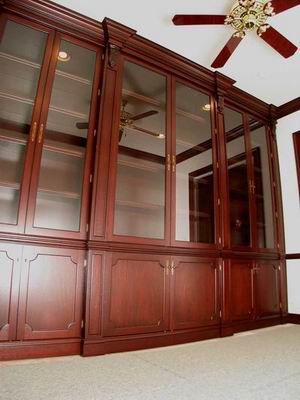Hanging Narrow Cabinets when Studs Aren't Available
Tips on supporting upper cabinets when sufficient nailing is not provided. August 23, 2006
Question
I'm trying to hang a set of four cabinets on a lath and plaster wall. The cabinets are all 30" tall and 12" deep, with two 9" wide cabinets at each end and two 15" wide cabinets in the middle. This set of cabinets starts to the right of an 18" wide pantry cabinet. The next stud to the right is 9" from the edge of the pantry. Any way I juggle them, the edge of the 9" cabinets falls on a stud, leaving the in a stud-free zone, and the 15's won't have more than one set of attachment points, top and bottom.
After pondering a while, I'm thinking I need to install a couple of 1 x 2 horizontal mounting rails through the wall to the studs, screw the cabinets to the rails and then hide the gap with molding or something similar. Suggestions? Fastener recommendations and lengths? And of course... I'm in the middle of trying to get this done before putting base cabinets under these.
Forum Responses
(Cabinet and Millwork Installation Forum)
From contributor J:
Cut the lath and plaster back the width of a 2x4 and the length you need at the top of where the cabs will mount. Pocket screw a 2x4 in between the studs, fill out to the thickness of the wall panel, hang your cabinets on the 2x4. Also, screw the cabinets to the pantry cabinet if possible.
Let the customer know the situation ahead of time and they will understand. Your screw length will depend on your mounting rail or if you are just screwing through the backs. Use cabinet mounting screws. They have a larger washer head and an auger tip. If going through 3/4 mounting strip, don't use anything shorter than 2 1/2".
From contributor D:
If that 9" cab is touching the pantry and one of the middle 15" cabinets, which I assume will be securely mounted to studs on down the row, just attach it to those two cabinets. It's only a 9" cabinet?
From contributor C:
Gang 'em together to make one 48" cabinet, and screw it in wherever you can.
From contributor J:
What contributor D said, if it's applicable. Much easier approach and will work fine.
From contributor B:
You are making mountains out of mole hills. Screw the ones to the studs that you can, screw the rest to the lath and plaster with adhesive caulking under all of them. Cabinet's not going anywhere any time soon. I wouldn't want to be the guy in the future trying to remove and save the cabinet for use elsewhere.
From contributor T:
If you recessed the backs of your uppers, then install a (hardwood) hang cleat to the wall studs and attach your boxes to the cleat.
From contributor S:
Can you attach cabinets to a French cleat? Assuming the cleat on the wall is very secure - this is for a custom job where the owner wants to take them with him when he moves. (Each cabinet is custom, like a piece of furniture.) The heaviest cabinet is about 30 pounds when empty.
From contributor O:
Ganging them together is the answer. Although in future you should consider recessing the back of your cabinets 3/4 of an inch and using a French in such situations. Plaster and lath stud walls are a blessing. Our nemesis is metal studs. The best approach we have come up with is to put a sheet of plywood the same size as the back of the cabinets and put drywall screws every 3 inches and then screw the cabinets to the plywood.
From contributor E:
Gang them together. Use the pantry cab to one side. The other 9" should be fine. After all, it is no different than hanging a 24 when you think about it. If you are really concerned, screw a piece of 1/4" on top of all four cabinets to tie them together from the tops when you gang them. Double up on the mounting screws where you do have studs. There is no rule that says you only have to use two screws in the top or in the top of the inside. If they are Big Box cabinets with 1/4 stapled backs, I would put a piece of 1/4" ply across the gang on the back and cover the outside corner with flat stock or quarter round. As mentioned before, explain to the customer what you are doing first so there are no questions later.
